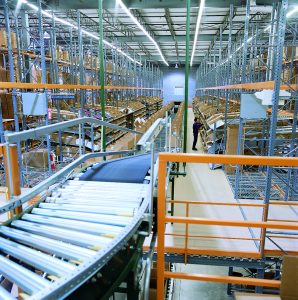How to Integrate Automated Conveyors into Pallet Rack Systems
In today’s high-throughput warehouses and distribution centers, integrating automated conveyor systems with pallet rack structures creates a powerful combination of space efficiency and streamlined inventory movement.
When conveyor systems are thoughtfully integrated with racking, facilities can achieve faster order processing, improved space utilization, and leaner labor requirements, notes Chris Aprile, Senior Structural Engineer with Steel King Industries.
Conveyor needs should be determined when a racking system is being planned, taking into consideration the weight, size and fragility of products being handled, material handling volume and flow, and automation initiatives regarding speed, accuracy and labor needs. Conveyor paths should line up with picking and packing areas, and transfer points between conveyors and racking need to be established.
If you were to consider adding conveyors after racking is designed and installed, significant modifications to the racking system could be needed to ensure the weight and movement of conveyors could be handled by the racking.
Safety and fire suppression are additional factors when integrating a conveyor system. This involves use of gates, railing and floor markings, and ensuring that conveyors do not block sprinklers.
Not all racking systems are conducive to conveyors within the system. They are best used in static racking and not advised for use within drive-through or drive-in racking systems where the constant movement of forklifts and their potential impact in racking could cause problems. But conveyor systems can be valuable when installed external of racking, such as in pallet flow, push-back and at entry ways and exits of drive-through and drive-in racking.
The most common type of racking – selective, is well served by conveyors that can feed picking zones within selective aisles.
 Four Approaches to Conveyor Integration
Four Approaches to Conveyor Integration
Following are four creative strategies to effectively integrate conveyors within pallet racking systems:
1. Support Conveyor Off the Pallet Rack
In high-volume pick modules, conveyors can be suspended directly from the pallet rack structure, extending out over aisles to move inventory seamlessly between picking zones and packing areas. Multi-level systems often utilize carton flow racks at the base and slower-moving SKUs on upper levels, with powered conveyors transporting picked items down through the structure to shipping stations.
2. Run Conveyor Through the Pallet Racking
Like subways running beneath city streets, conveyors can be routed through racking and across aisles to maximize floor space. This design requires careful structural reinforcement, such as rack ties and steel support beams, to handle the conveyor’s weight and movement. Custom engineering ensures both safety and efficiency.
3. Mount Conveyor Along the Rack Side
Instead of using ceiling mounts or standalone supports, conveyors can be secured to the sides of pallet racks. Special brackets and reinforced rack components like wider cross beams help manage the dynamic loads. This setup keeps the conveyor aligned with existing material handling pathways while saving valuable overhead and floor space.
4. Use Pallet Rack for Conveyor Maintenance Access
Conveyor systems demand regular maintenance, and accessing overhead units can be challenging. Installing bar grating platforms within the rack structure provides safe, stable access for inspections and repairs—eliminating the need for lifts or ladders. Maintenance schedules include daily visual checks, monthly mechanical inspections, bi-annual motor readings and lubrication, and annual belt and frame evaluations.
Integrating conveyors into pallet rack systems enhances warehouse performance by unifying structural and automation strategies. With proper design and expert input, these integrations can improve throughput, safety, and long-term operational resilience.
SOLUTIONS FOR EVERY INDUSTRY.
Questions? Contact UsContact Us ![]()


